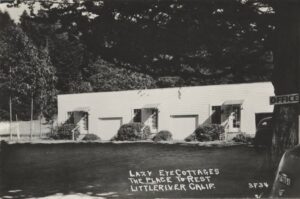Katy Tahja’s article a couple of weeks ago about the Point Cabrillo Auto Court got me wondering about other auto courts and where people used to spend their nights when visiting the Mendocino coast.

Back in the late 1800s (and before), people would walk to the coast, or use horsepower to convey themselves and their gear. As better roads were constructed, travel became easier and more accessible for those wonderful new inventions – automobiles.
By the early years of the last century, more and more people were traveling via motor car. Newspaper accounts describe the roads thick with tourists, who were generally welcomed as customers for local stores. But where were these hordes of visitors going to stay?
Travelers’ hotels had been available in our coastal towns from the first but were often distant from the fishing spots and scenic destinations sought out by motor-driven tourists. With trunks packed full, they often stayed for weeks and needed less expensive accommodations than those provided by hotels. So, if they had no coastal friends to stay with, they just pulled over and camped wherever there was a wide place in the road.
As we know, crowds of people and their cars can cause quite a bit of environmental damage. Compacted soils, mangled vegetation, and spilled oil and gas combined with the refuse and offal generated by temporary human habitation were creating unsanitary, unsafe, and increasingly unwelcome situations.
Landowners along the traveled ways saw a money-making opportunity here and responded by creating safe stopping places for the motorists. Initially called auto camps, they provided affordable, rustic accommodations for travelers and their vehicles, with access to potable water, firewood, and outhouses.
Municipalities around the country also recognized auto camps as a solution to unattractive road-side squatting. Mendocino City embraced this concept quite early, and in 1915 opened Grindle Park on the north side of Little Lake Road “for the pleasure and recreation of the people of Mendocino and all visitors to our town.” For many years, its well-maintained facilities made it ideal for family parties and local events, as well as tourists and campers. Later it was leased to private parties and called Mendocino Pines Auto Court. It is now the site of the Mendocino Fire Station #840.
Small clusters of one or two-bedroom cabins continued to spring up on former farmland adjacent to the highway, like those at the Point Cabrillo court in Pine Grove, just north of Mendocino. Here, the family farmhouse of the Hedden truck farm and orchard became the onsite owner-manager’s quarters, a typical setup seen in many other courts created in rural areas.
What made these places unique was how both the auto and the traveler were physically accommodated, with the car parked right next to the lodging, either on adjacent driveways or in attached garages like those at the Lazy Eye Auto Court south of Little River, pictured here. Started in 1932, you can still see these buildings in its present incarnation as The Inn at Schoolhouse Creek.
All the way up the coast you could pull off the road and find a roof with a parking place. Down south in Point Arena, one could stay at the Halliday Cabins, or the popular court run by Mr. and Mrs. George Myland. In Manchester, there were the Bishop cabins, and W. P. Gillmore built a camp on the Navarro River flat.
Little River was well supplied with overnight motor stops. In addition to the Lazy Eye Cottages, there were the Silver Fox Cabins, now called Cottages at Liver River Cove. Silas W. Coombs’ Little River Campground was incorporated into the new Van Damme Memorial State Park in 1929.
Just north of Mendocino, J. O. Pilcher used the materials from the old brewery there to build the Agate Beach Auto Court, now called Agate Cove Inn. On up the highway, H. F. Mallory transformed in 1938 the popular dance platform at Mitchell Creek into the Pine Beach Auto Camp, now a motel and restaurant with the same name.
One of the oldest was the Noyo Beach Auto Camp on the bluffs above Noyo River. It was once the site of lumber magnate Alexander Macpherson’s home. The very large, circa 1850 dwelling and eucalyptus grove were a part of the facility from the 1920s until 1935, when the redwood-timbered house was dismantled to build new cottages. Over the last century, it expanded from auto camp, to auto court, to motel, until today it is the Harbor Lite Lodge.
Our research for this article revealed more than 30 auto camps and courts along Highway 1, but we know there are more. If anyone has memories, photographs or memorabilia of these lodging places, contact us at curator@kelleyhousemuseum.org. We would love to expand our documentation of traveling here on the Mendocino Coast.